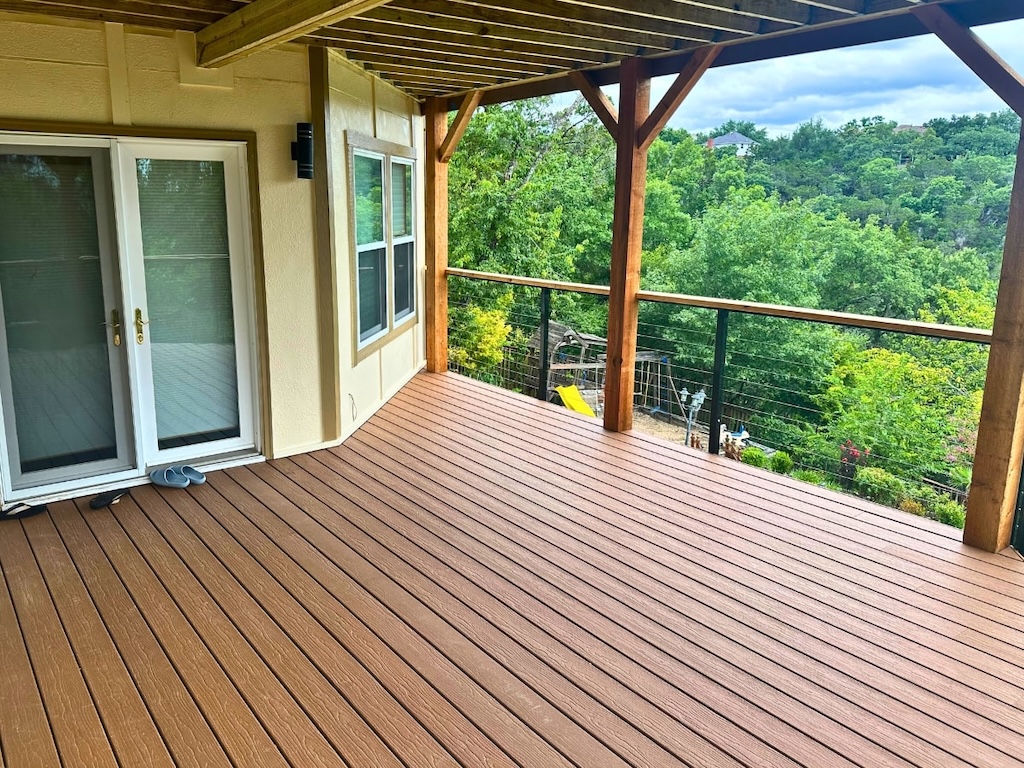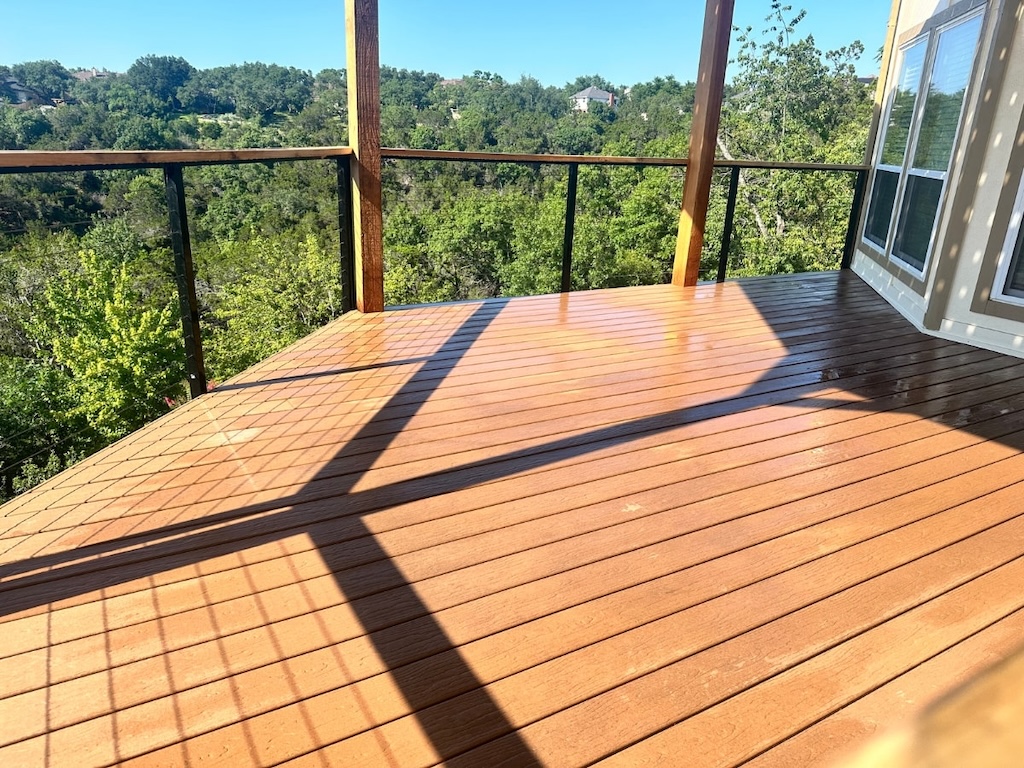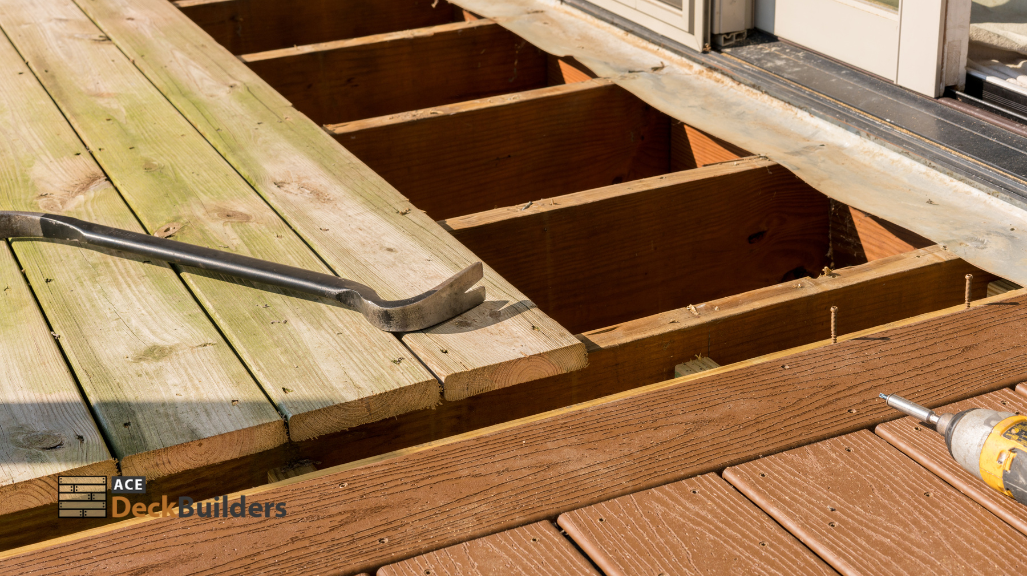TL;DR
Austin’s heat and UV change the composite decking game. If you want the lowest upkeep and steady appearance, go with capped composite or PVC in lighter tones. If you want cooler underfoot and a natural feel, cedar or pressure-treated pine can be great—just budget for regular stain/seal cycles. For ultimate durability and a premium look, tropical hardwoods like ipe shine but require specialized installation and periodic oiling. Whatever you choose, performance depends on framing spans, ventilation, fasteners, and inspection-clean details. To see the craftsmanship and clarity you should expect in Central Texas, browse Ace Deck Builders.
Table of Contents
ToggleWhy Austin’s Climate Changes Your Decking Choice

Austin is a “sun-first” market: high UV levels, long, hot spells, and pop-up storms, which highlight the challenging weather conditions . That means two things:
- Surface temperature and color stability matter more than in milder regions.
- Water management (flashing, ventilation, gapping) dictates lifespan as much as the board brand.
Even the best board struggles with undersized, poorly ventilated framing. Start with structure, then pick the surface.
How to Decide (Before You Fall in Love with a Color)
Use these three filters in order:
- Sun Map – Where does the deck bake between noon and 6 pm? West- and south-facing exposures push you toward lighter tones and matte textures.
- Maintenance Appetite – “Rinse and relax” favors composite/PVC; “I don’t mind staining” keeps cedar/pine in play.
- Barefoot Comfort – Lighter tones feel better; textured, matte embossing helps; shade planning beats any brochure claim.
Once those are set, talk about budget, railing style, and skirting/fascia.
The Top 5 Decking Materials for Austin
1) Pressure-Treated Pine (Southern Yellow Pine)
Why Austin homeowners pick it:
The most affordable path to a functional, good-looking deck. It’s easy to work with, readily available, and—when regular maintenance is properly done—delivers years of service.
Pros
- Lowest upfront cost; flexible for custom shapes
- Cooler than many dark engineered boards in direct sun
- Easy to repair or modify later
Cons
- Needs regular stain/seal (12–24 months, exposure-dependent)
- Prone to checking/splinters if neglected
- Chemical treatment = choose fasteners/hardware carefully
Best fit
Budget-sensitive projects, shaded or morning-sun decks, and owners who’ll keep up with finishing.
Install musts
- Correct spans; sealed end-cuts; corrosion-resistant fasteners
- Ventilation under low decks; skirting that breathes
2) Western Red Cedar
Why Austin homeowners pick it:
The classic natural look of wood decks with a cooler underfoot feel and less weight than dense hardwoods.
Pros
- Comfortable in bare feet; lovely grain and color
- Lower board temperature than many dark synthetics
- Easier on fasteners/tools than hardwood
Cons
- Requires consistent stain/seal cycles
- Softer surface: plan for pet traffic and furniture movement
- UV graying without maintenance
Best fit
Design-forward decks that value natural warmth, with a homeowner committed to a finish schedule and possibly some targeted shade.
Want to see how natural-wood projects are planned and fastened for longevity? Mid-research, review a service walkthrough for wood deck installation to understand spans, end-cut sealing, and finish schedules in Austin.
3) Capped composite

Why Austin homeowners pick it:
The “set it and forget it” choice is popular for many who prefer composite decks. Modern composites pair durable cap layers with realistic textures and colors.
Pros
- Low routine maintenance; strong color stability
- Hidden fasteners/plug systems for clean finishes
- Broad style range for modern or traditional homes
Cons
- Darker tones can run hot in full sun
- Must respect gapping/ventilation to avoid movement issues
- Mid-to-high upfront cost
Best fit
High-use outdoor spaces where owners want rinse-and-relax maintenance and a consistent look year after year—especially in lighter tones for west- and south-facing exposures.
Curious how composites are detailed to protect warranties and comfort underfoot? See the specifics of the composite deck installation—from joist spacing to fascia ventilation and hidden fasteners.
4) PVC (Cellular/Capped)
Why Austin homeowners pick it:
Top-tier moisture resistance and excellent color stability —ideal near pools or under heavy irrigation.
Pros
- Minimal ongoing maintenance; highly stain/moisture resistant
- Often dimensionally stable when installed per spec
- Pairs nicely with premium rail systems
Cons
- Highest upfront cost
- Needs correct edge support and fastening
- Dark tones can still feel warm—tone matters
Best fit
Poolside decks, heavy-irrigation landscapes, or homeowners prioritizing long-term appearance with the least maintenance.
5) Tropical Hardwoods (Ipe, Cumaru, Tigerwood)
Why Austin homeowners pick them:
Luxury look with exceptional density and durability; when oiled, the color and figure are striking.
Pros
- Extremely durable and wear-resistant
- Premium aesthetic; excellent structural feel
- Ages gracefully (silvers) if you choose a low-maintenance look
Cons
- Heavy and labor-intensive; pre-drilling required
- Higher material + install cost
- Periodic oiling if you want to retain the rich color
Best fit
Showcase spaces, elevated decks that need a stout feel, and homeowners who are comfortable with either natural silvering or scheduled oiling.
Comfort Underfoot: Heat & Texture Reality
In Austin, color choice impacts comfort as much as material tech. Lighter tones reflect more sun and feel better at 3 pm in August. Matte, embossed textures are friendlier to bare feet than slick, glossy caps. If comfort is a must, plan targeted shade—a small pergola zone or sail over the grill/lounge area beats fighting physics.
Maintenance: The 10-Year View
- Pine/Cedar: Clean + stain/seal every 12–24 months, depending on exposure. Skip cycles and you’ll spend more on recovery later.
- Composite: Rinse, occasional soap scrub; no staining.
- PVC: Similar to composite, often even more stain-resistant.
- Hardwoods: If oiled, plan periodic refresh; if silvering is acceptable, maintenance drops.
If your calendar is already full, engineered boards (composite/PVC) in lighter tones are your friend.
Cost Ranges & What Actually Moves the Budget

Board selection matters, but rails and stairs move the number more than most expect.
- Entry (pine/cedar): lowest upfront, more lifetime care
- Mid (composites): higher upfront, steadier 10-year cost
- Premium (PVC/hardwoods): highest upfront, premium look/feel
Budget levers you control
- Choose in-stock board lines and simple picket rails
- Consolidate stairs to one run where practical
- Standardize dimensions to 12/16/20-ft board lengths to reduce waste
- Pick lighter tones to improve comfort without buying immense shade structures
Want a broader, side-by-side material primer before you lock your spec? Skim this homeowner’s guide to the best types of deck materials to see how categories compare on heat, upkeep, and warranties.
Design Tips That Elevate Any Material
- Two-tone picture frame: adds polish and helps control gapping on long runs.
- Divider boards: Manage expansion and reduce visible seams.
- Matte finishes: Hide dust/prints better, read cooler visually.
- Ventilated skirting: Critical for low decks—protects framing and keeps surfaces cooler.
- Railing discipline: A clean, simple rail with a premium board often looks “high-end” from 10 feet away at half the cost of cable/glass systems.
FAQs
Lighter-toned cedar is often cooler than dark composites. That said, light composites/PVC paired with a bright shade can feel just as comfortable. Color is the significant variable.
Quality-capped boards handle color well, but all materials change color to some extent. Expect the most stability from plastic PVC and top-tier capped composites—especially in lighter tones.
Only if the frame meets current span/spacing rules, has a properly flashed ledger, and passes inspection. Many older frames need upgrades—especially when switching to engineered boards.
They’re incredibly durable, but they still need correct fasteners, ventilation, and thoughtful detailing. Decide whether you want oiled color or natural silvering.
Favor textured, matte boards in lighter tones, and use manufacturer-approved fasteners/edging. Consider stainless hardware in splash zones.
Get a Materials Recommendation You Won’t Regret
Want a side-by-side deck design plan for your sun exposure, rail length, and budget—plus a schedule tied to inspection hold points? Start with a free deck estimate in Austin. We’ll bring samples to heat-test, map maintenance over 10 years, and deliver an itemized proposal you can act on.
